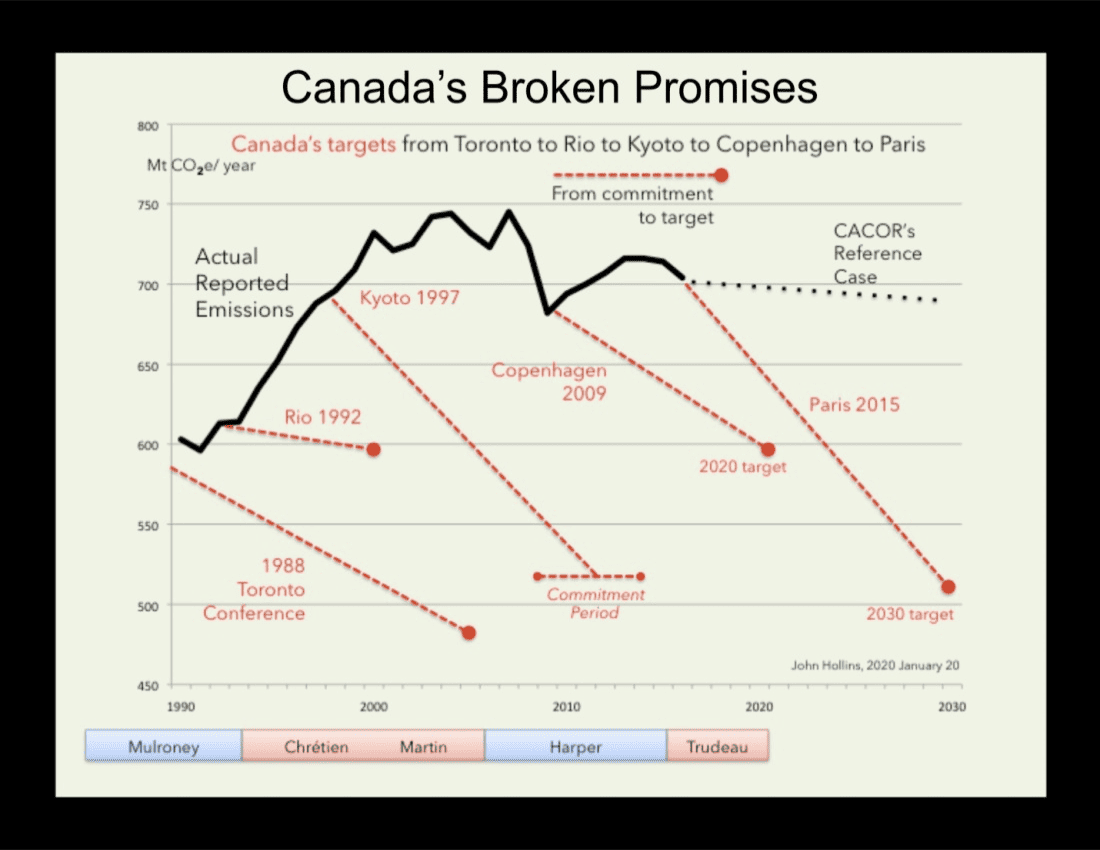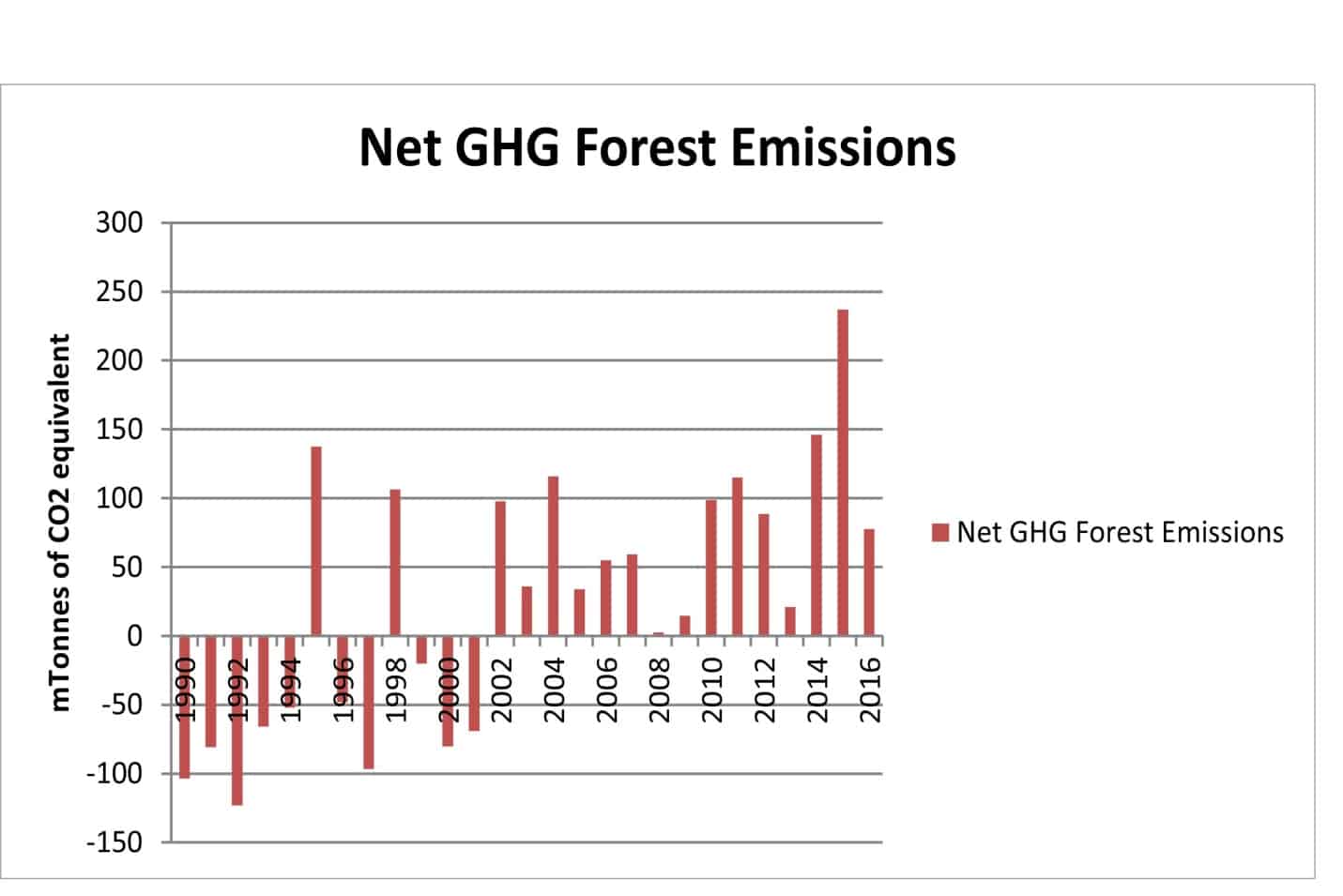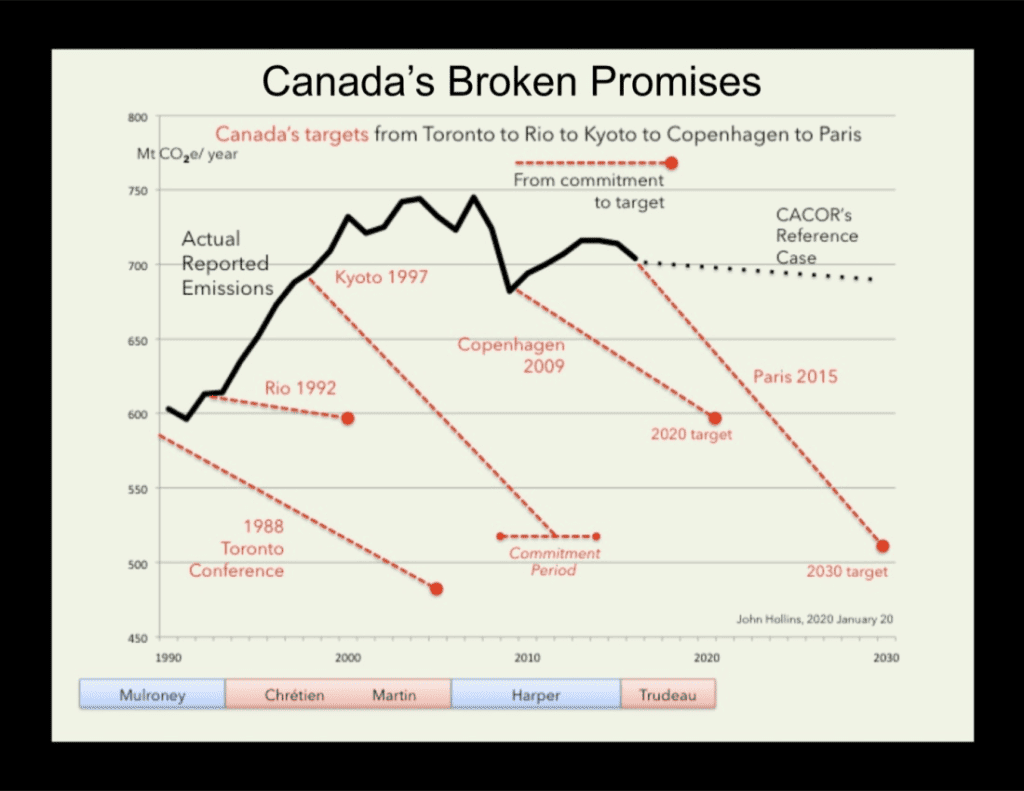Donald Trump (yes, that Donald Trump) beat Justin Trudeau in the race to reduce Greenhouse Gas Emissions
We can safely put Canada’s Climate Action Plan 2030 announcement in the same category as Justin Trudeau’s “Canada is back!” claim. In the period 2016 to 2019, JT’s “We’re Back!” Canada was outperformed on emissions by Donald “Climate Change is a Chinese Plot” Trump. US emissions went up 0.6% over that period and Canada’s went up 3.4%.
Why? Fortunately, Trump’s promise to bring back coal didn’t happen because the much cleaner natural gas was much cheaper. Who would invest in a coal plant anyway? So, out of sheer luck, US emissions stayed pretty much level from 2016 through 2019.
Trudeau though managed to expand the two programs which increase Canada’s carbon emissions, namely, mass immigration and oil sands production. These are the prime drivers of our emissions growth over the past 20 years and Trudeau is ramping up both of them regardless of their climate impact.
Canada’s disgraceful climate record graph.

The Canada Climate Action Plan 2030 looks to be more of the same designed-to-fail-but-look-good-announcing-it efforts we’ve seen for the past 25 years.
It has all of the typical growth lobby manipulation fingerprints of dead-end initiatives and fuzzy metrics to look like action but end quietly. The Action Plan contains the following distract/delay/misinform classics:
- Carbon capture and storage.
- Hydrogen (Blue, Green, whatever)
- Biofuels
- Population growth is not a variable, it is pre-determined.
- Energy/GDP intensity
CCS, biofuels and hydrogen are being cited as the means to contribute 25% of total emissions cuts.
- Carbon Capture has been failing for decades all around the world and is a means of propping up fossil fuel consumption. The EROI (Energy Returned on Energy Invested) of any fossil fuel source drops precipitously when carbon capture is added into the process.
- Leading climate scientists and academics are calling on the federal government to abandon a proposed tax credit that gives big polluters a break for investing in carbon capture technology.
- The experts say the planned carbon capture utilization and storage (CCUS) tax credit will lock in fossil fuel use and risk ruining Canada’s chances of meeting emission reduction goals.
- In a letter signed by more than 400 experts and sent to the federal government’s finance, natural resources and environment departments Wednesday, the group warned a tax credit that incentivizes carbon capture technologies amounts to a major new fossil fuel subsidy — something the federal government has repeatedly promised to phase out.
- “When we’re focusing our resources and attention on technologies that are prolonging fossil fuel use, it means we have less resources and less attention to focus on technologies and innovations that will allow us to move away from fossil fuel use,” said Christina Hoicka, an associate professor at the University of Victoria who drafted the letter with a handful of others.
- In Canada, SaskPower’s coal-fired power plant Boundary Dam installed a generator equipped with carbon capture technology in 2014, initially promising to trap 90 per cent of emissions. Boundary Dam is one of the country’s top emitters, pumping out about five million tonnes of greenhouse gas emissions in 2019. According to the Institute for Energy Economics and Financial Analysis, the plant has consistently failed to meet its promised carbon capture goals. Its plan to capture 90 per cent of emissions was dropped in favour of an easier 65 per cent target, but the facility still fails to regularly meet that, too.
- Hydrogen is a very energy inefficient process and might be suitable for some niche applications but certainly not for any mainstream systems.
- Blue hydrogen is produced from natural gas with a process of steam methane reforming, where natural gas is mixed with very hot steam and a catalyst. A chemical reaction occurs creating hydrogen and carbon monoxide.
- Green hydrogen produced by splitting water into hydrogen and oxygen using renewable electricity. What a waste of renewable energy!
Whether originating from “blue” or “green” processes, hydrogen has little practical application.
- Biofuels are mostly ethanol from crops or sawmill waste or wood for woodstoves. Locally sourced, (preferably on one’s own land), firewood is energetically worthwhile. But growing crops, primarily corn, to produce ethanol is a waste as the EROI is close to 1:1. In other words, it takes almost as much fossil fuel energy (and maybe more) to produce the ethanol than the ethanol produces. Biofuels are a non-starter at most North American latitudes.
- Backroom deals assure the Canadian population will continue growing by 1.1% annually and this is the biggest contributor to our carbon emissions growth even exceeding that of the oil sands. In the Climate Plan, high population growth is a base assumption but should be a key variable decided upon in an open and transparent manner in the best interests of Canadians and the land. The environmental assessment of mass immigration has been evaded and denied. Tripling Canadas population to over 100 million, which is what current immigration policy is tracking, is immensely destructive both environmentally and socially.
- Energy intensity of the commercial economy (carbon emissions per $ of GDP) is being cited by the Report as a measure of progress. In other words, keep emitting what we are now, inflate property values and print more money and this metric indicates we are making strong progress. It is evasion at its finest. Mother Nature doesn’t care about money flows or what the size of the commercial economy is, she only cares about the amount of carbon we are pumping into the atmosphere. Carbon intensity is designed to obscure reality and deflect and delay effective action.
Further, there is no biophysical overview or modelling guiding the recommendations which are a collage of mixed indicators obscuring any direct action or pathways. Where is the pathway and what is the goal?
Doug Ford and EVs
After cancelling Ontario’s green plan, ripping EV charging stations out of Go Transit parking lots and eliminating EV incentives, Ontario’s Doug Ford and Economic Development Minister Vic Fedeli claimed Ontario would now become a world leader in EV production.
Vic, it is nice of you to go down to the dock and declare that this ship was coming in but, in fact, the EV leadership boat sailed 15 years ago. To get right down to it, you chased it out of port and told it to never return. It’s nice to see you are having a change of heart, or at least a change of tone in your press releases, but becoming a leader requires both a goal and a strategy and you and Doug Ford have neither.
Well, at least Ford isn’t intending to tear out any more charging stations but his target of 400,000 EVs plus hybrids by 2030 is brutally and uselessly low. With the Ontario population projected to grow by 2 million due to Ford’s mass immigration policies, it means there will be another 1.2 million vehicles on the road bringing the total to nearly 10 million.
If only 400,000 of these are hybrids and EVs – only EVs make a real difference – then emissions will actually continue to increase. Well done press release though! The growth obsessed media ate it up and certainly didn’t ask any questions like “How does this solve the problem?”
Forests, the Saviour
Forests and tree planting were everyone’s Great Green Hope two decades ago but reality set in and they are no longer seen as a salvation even if they were healthy. But sadly for all of us, due to climate change and urban expansion, they are not. Forests in Canada are now net emitters of carbon thanks to forest fires and invasive species and in the worst years send more carbon into the atmosphere than the oils sands (100 mega tonnes annually).

The math below illustrates why growing trees, although it is still a solid positive for the planet, can never deliver climate salvation for our fossil fueled society.
Annual global CO2 emissions = 36 giga tonnes
Amount of carbon absorbed annually by a mature tree = 50 pounds
Number of trees required to absorb 36,000,000,000 tonnes of CO2 = 1.6 trillion
If the lifecycle time of a tree is 60 years then the number of successful, mature and growing trees we have to plant every year is 26 billion trees. (1.6 trillion / 60 ) This effectively adds to our stock of carbon above the ground to balance the stock of carbon below the ground we are pumping out.
Currently, we are planting 1.9 billion trees a year globally or 7% of the level that would be needed.
Number of trees on our planet now = 3 trillion
Planting trees can offset only a small portion of our carbon emissions but remains one of the many positive actions we must take. Please keep on making an effort to plant trees and prevent urban sprawl! Also eliminating clear-cutting would be a big step forward.
Conservation and Population Stabilization are Real Solutions
Canada needs an effective climate policy, one with clear biophysical actions aimed directly at solving the problem in a coherent strategy. Conservation and population stability must form the starting point for this effort. They won’t guarantee success on their own but make success a possibility. But consumption reduction and an end to population are an anathema for the portions of the commercial economy whose life-blood is growth. Developers, speculators, debt mongers and media corporations (the money economy) depend completely on an increasing population and ever higher consumption.
The real economy does not. Stability is just fine for service providers, farmers, manufacturers, medical companies, educators and all producers of real goods and services. Be sure to get politicians and media to identify which economy they are talking about – real or money – when they promote economic growth. Also ask them who they think benefits from bigger cities, less farmland and higher ghg emissions and housing costs.
References
https://canadiangeographic.ca/articles/a-brief-history-of-canadas-climate-change-agreements/
Orca CO2direct air capture plant in Iceland.
-DAC facility in SE Saskatchewan claims 15 tonnes/day ≈ 5,500 tonnes/year
-Orca (can) capture up to 4000 tonnes of carbon per year.
Global emissions in 2021, 36 GT (giga tonnes) = 36,000,000,000 tonnes(36 billion)
-36,000,000,000 tonnes/10,000 tonnes=4 million facilities to remove annual emissions!
https://www.gotreequotes.com/how-many-trees-are-planted-each-year-month-day-minute-second/
Approximately 1.9 billion trees are planted each year according to statistics compiled from different sources including the United Nations Environmental program.


